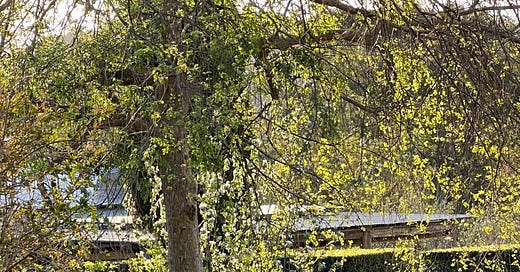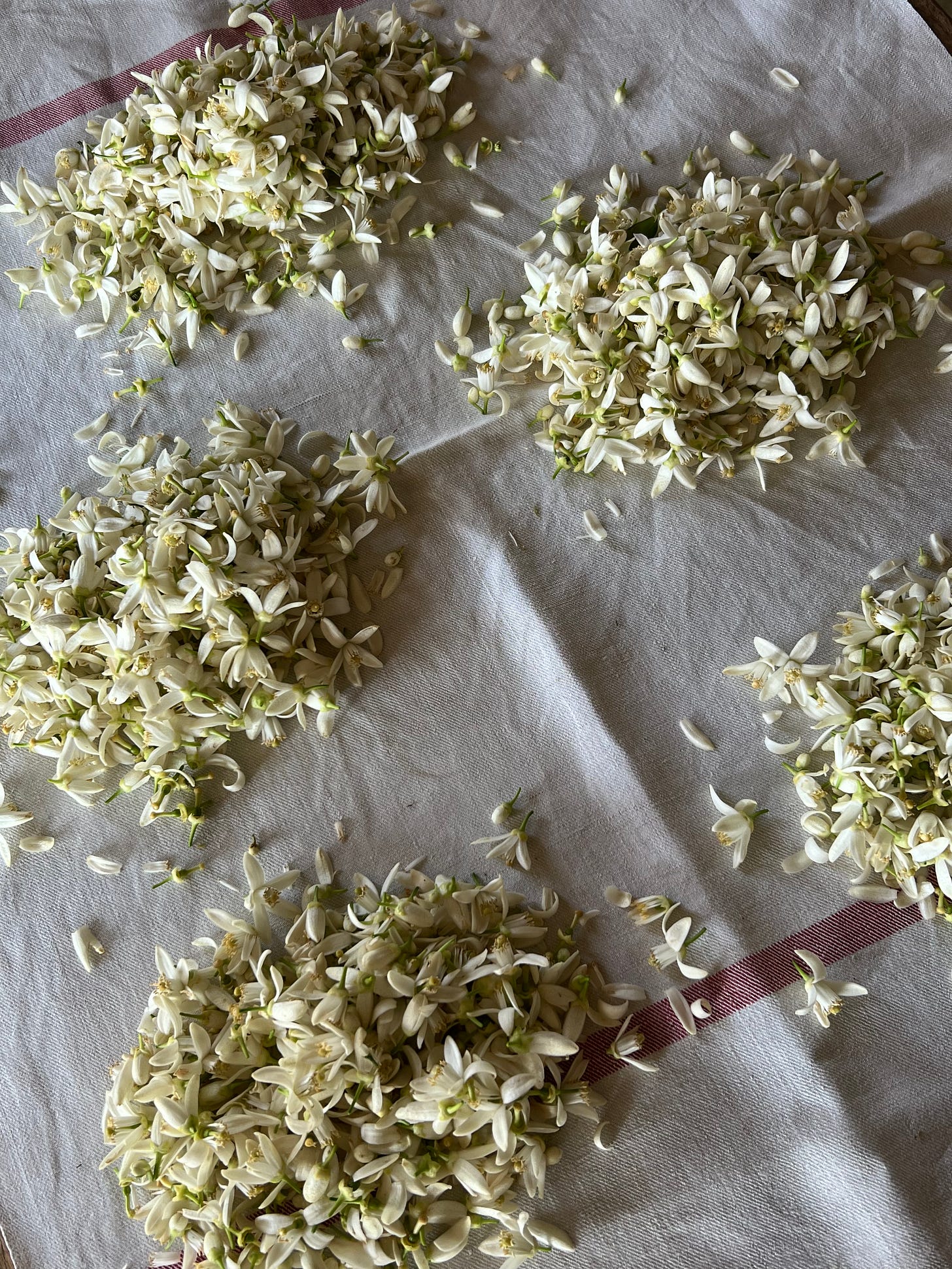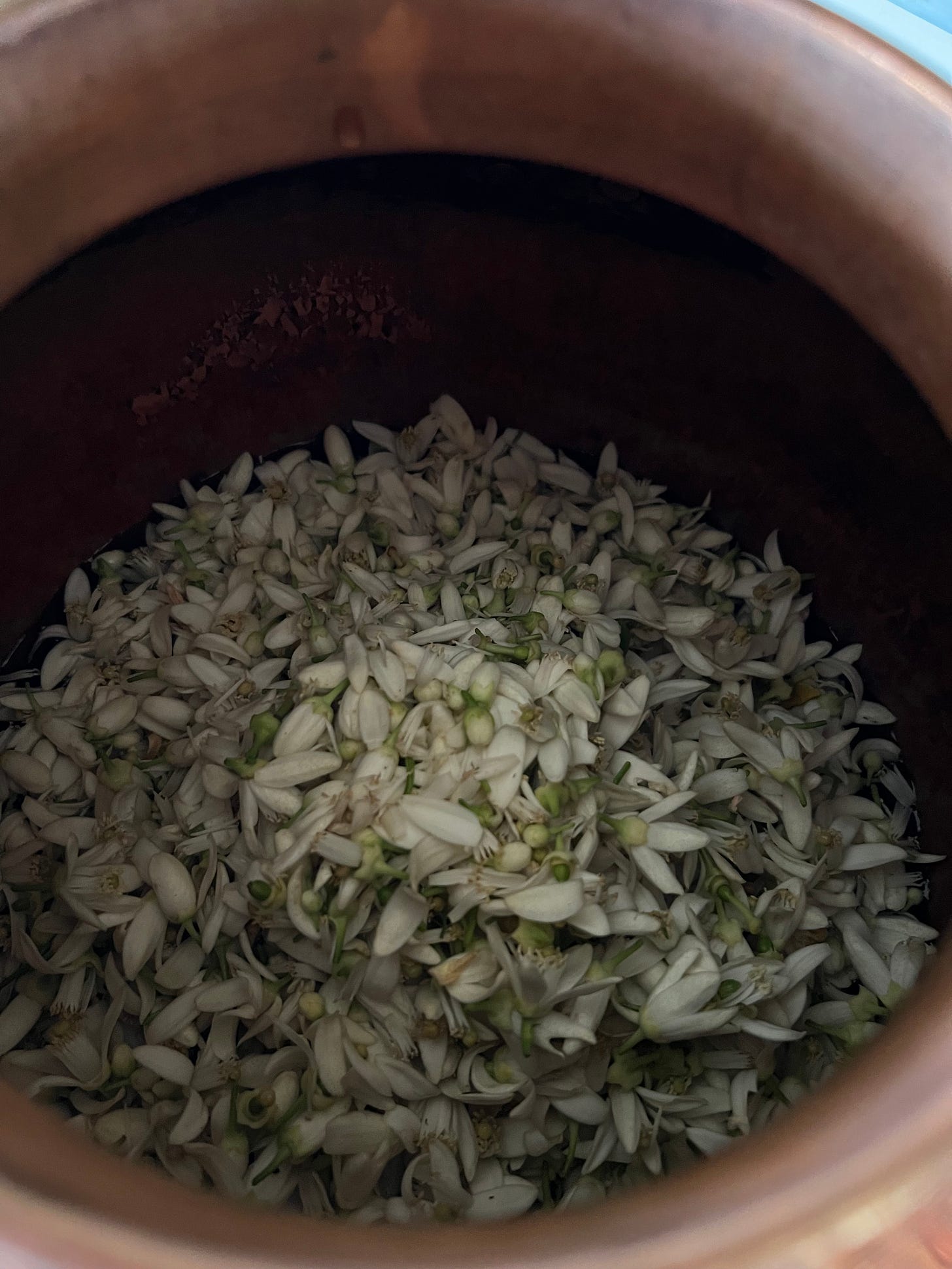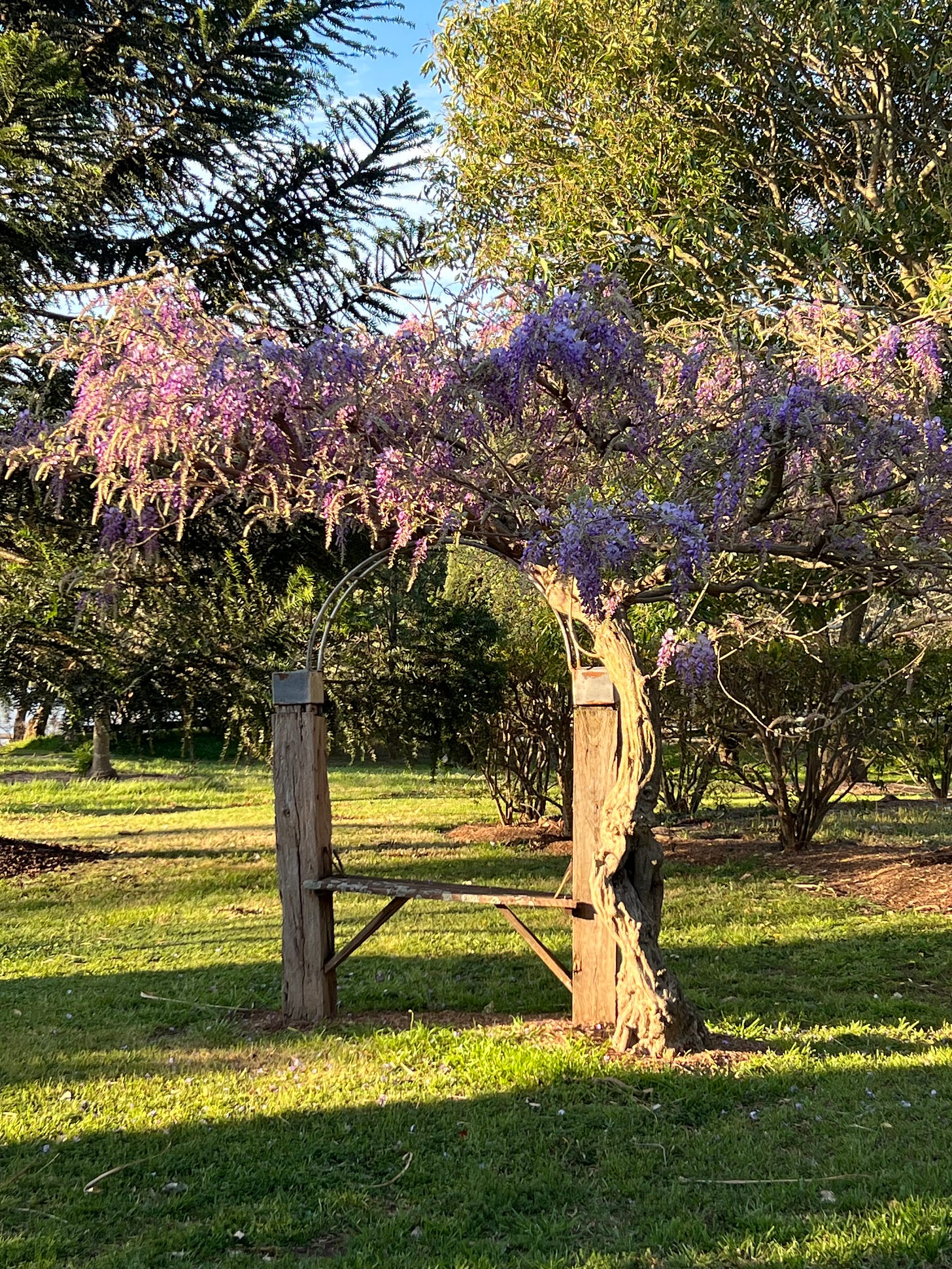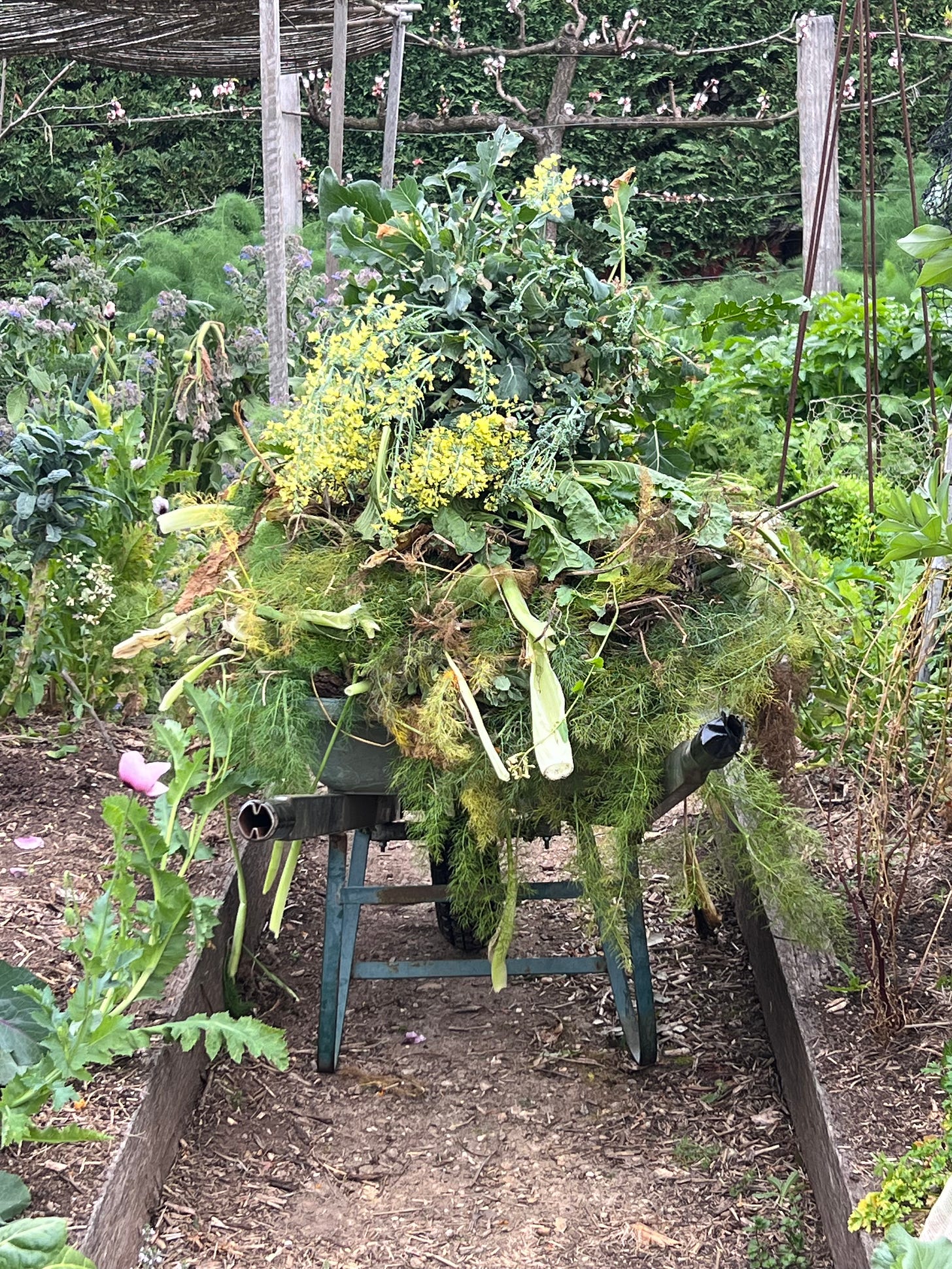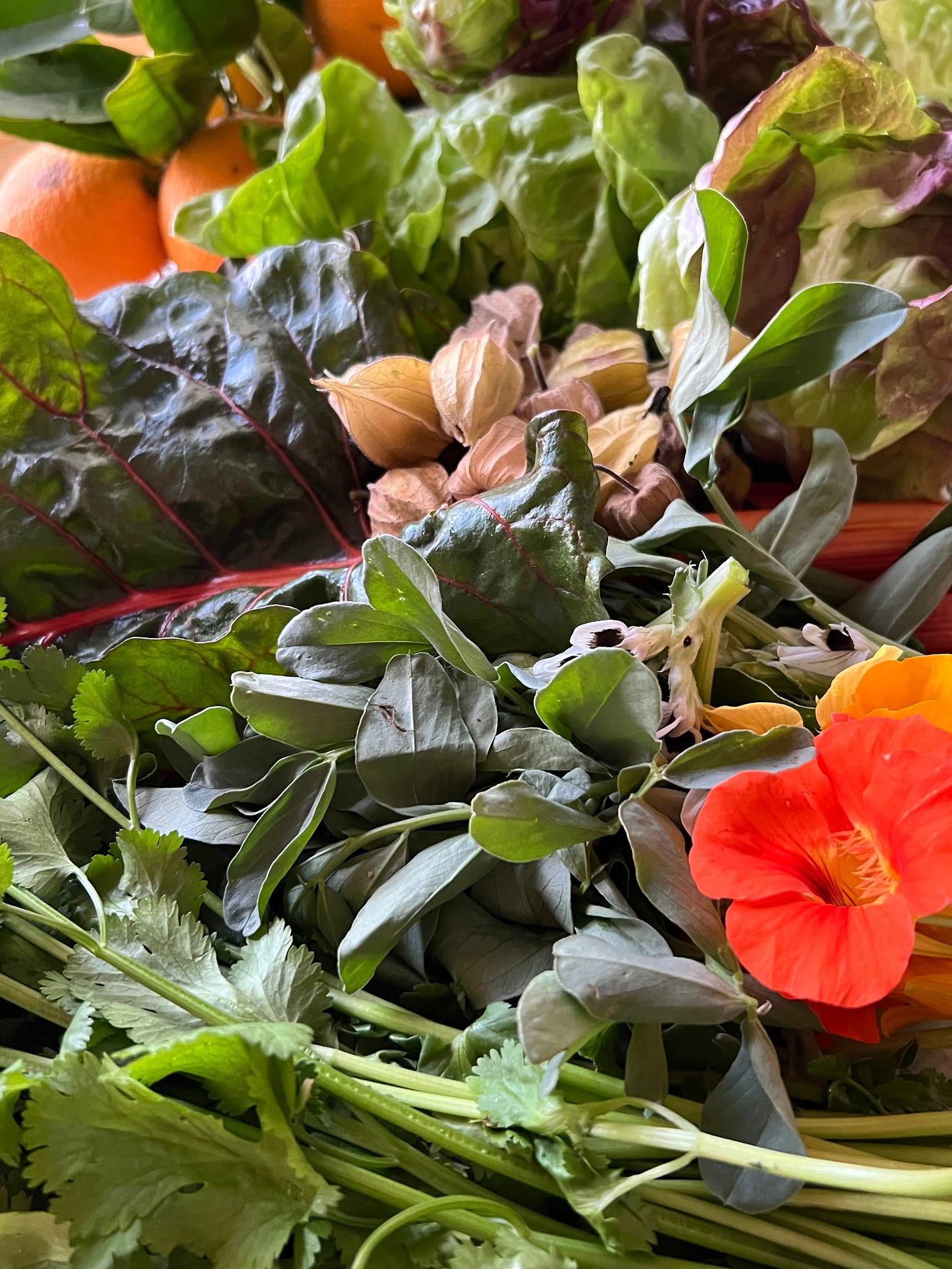Spring…in all her splendour, has ricocheted around all over the place this week as temperatures veer wildly from one extreme to the next - all we can do is aim to maintain a steady path…
And the path I’ve been most drawn to, is the one by the orange trees! How those trees have beckoned, teased, tempted. I think I mentioned last week that just a few early blossoms had unfurled their waxy petals, and that is all it takes to infuse the atmosphere with intoxicating perfume.
The trees are smothered in blossom, but at the weekend it was mostly held in tight bud - full of anticipation. It’s early. No earlier than last year, but a fortnight earlier than the one before, and the one before that.
Following on from yesterday’s special post on the backstory to the Botanical Waters; now it’s relevant to divulge how a likely distillation comes about! It isn’t something that can be overly planned…it’s a feeling, combined with observation…a niggling that evolves into a sense of palpable urgency, a hope that can only be brought to fruition if…
And only if there’s enough botanical material in weight (in this case orange blossom) to go ahead! With an eye on the weather reports, both local and afar, gradually a culmination of circumstances arouse possibility, and once that moment is reached..one of pure, unadulterated excitement takes over and the fantastical process can begin!
So it was on Tuesday morning. With perfume flooding the kitchen garden as I carried out my early morning water, I dared to look more closely and thought to get a colander and see the likely quantity of a quick pick. The bulk of blossoms in that first colander looked promising…so by the time I’d accumulated a second, I knew the first distillation of the season would be carried out that day!
It’s then the task begins in real earnest: no open blossom will be left unplucked! (I’ll come back to this point - never fear…there will be plenty for the bees and we will also have plenty of fruit…I can assure you!).
If you’d told me ten years ago I’d be climbing trees in my early sixties I’d have laughed! Sure…in the scheme of things, it’s a very small tree, but I cannot reach the blossom at the top without climbing it. Thank goodness I did a reasonable pruning job in the early years, although had I realised what I’d be up to decades along, I might have taken a slightly different approach! The point at which its branches fork from the main trunk is slightly too high, but with effort I can get a sure enough foothold to enable me to haul myself up…and the branches are sturdy enough for me to get into several different positions in order to carefully do a 360 degree sweep! By the time the sun was high I’d spent the morning outstretched to the limits of my fingertips and twisted like a pretzel…crawling on the ground to pick from the lowest branches, and atop the wall for the high blossom facing east. I begin in the east, work around to the north, then pick from the centre, the west and finally the south…as should the heat of the sun intensify, it will brown off the petals…and we can’t have that.
Each blossom, for the most part, must be plucked individually. Some branchelets have multiple open blossoms which makes for a speedier catch - thrill. All the time the bees too, are about their work…busy, buzzing; sometimes their wings brush my cheek and sure we’re all high on the heady fragrance that saturates the air. That perfume…that’s the essence I so wanted to capture all those years ago. It’s the dense aroma that envelops you when you’re in the tree, so intense it makes you giddy (perhaps not a good idea when climbing its branches!).
I choose to take the blossom from the Navel oranges. We have a pair. Funny…I hadn’t particularly noticed ‘til I began this distillation lark that the blossom on the Valencias is quite different - it’s larger, heavier…and not so sweet. As I truly am distilling on a micro level, the two trees provide me with plenty of blossom for my purpose…in the same way they provide us with plenty of sweet fruit.
As with any distillation…collecting the botanicals is a huge part of the process. It marks the beginning, takes the longest amount of time (usually) and of course is simply the most delicious, multi-sensorial thing to do.
Once the botanical material is in…the process can begin. Whilst Hildegard lets off some steam (I always do a dry run in preparation for the distillation ahead) I weigh the blossom…it’s only then I can ascertain the amount of water needed and the likely yield. I sterilise my glassware and then…we’re ready to go.
In the case of Orange Blossom, it’s a hydro distillation process, so the column section of the Still isn’t used. Into the water the blossom goes…
All the parts of the Still are attached tightly and in a final gesture, I bandage Hildegard with a length of pure linen to seal in any steam that could otherwise escape the join between her two main parts (traditionally this is done with a rye slurry…I decided early on that was too much mess to deal with…believe me…the linen does an excellent job!).
Once everything is secure, I fire her up, switch on the pump and watch the water rise around the coil in the condenser pot (careful to adjust the flow) and begin my notations. All the while, there’s a methodical rhythm, as I tick off a mental checklist. For these distillations, I work quietly, and alone (except at workshops). As the temperature gauge slowly rises, a sense of calm ensues…
As the cooling water (generated by a pump from a vessel below) moves around the condenser coil (flowing in at the bottom, and out at the top), there’s a gentle splish-splosh and from time to time a gurgle, a belch…as air and water vie for space, keeping each other on the move.
And then…an overwhelming wave of perfume engulfs the senses. As the first drop is about to appear…the anticipation is tremendous…and there it is! One drop, then another; then a trickle, a fine stream…the distillate, the pure Botanical Water is on its way!
And that…is how batch #one Orange Blossom 2024 was captured!
It isn’t as large an amount as I’ve had in previous years. Every drop really is precious and any distillation cannot be guaranteed. Remember I was worried I was pruning the trees too hard? Well - they needed it, but I did stop as I really was worried I might not be able to take an orange blossom distillation at all! I’m quite happy to take several smaller ones though, and rarely manage more than three: it’s an assured thing that there will be wind, hail or some other calamity to put paid to the opportunity to run more and also…other facets of life must go on! So distillation literally must done on gut instinct, that spur of the moment whim…when everything aligns…because there may not be another chance. Tomorrow’s opportunity may never arise.
I’ve taken two small distillations this week. Woohoo! They’re now labelled and sitting in the cellar where, as the molecules re-order themselves and the distillations ‘develop’ over the coming weeks and months, the cloudiness that accompanies all distillations will gradually settle, and the resulting Botanical Water will be clear as a bell. Will there be another orange blossom distillation this year? I hope so, but I can’t be sure…
On the bee foraging and fruit subject…blossom continues to open throughout the day..long after I’ve picked. I don’t (and simply cannot!) pick every day! As the days go by I can see very clearly which blossom has been pollinated - even at this early stage, the makings of a tiny fruit are visible. So everyone is happy…there’s a good chance bees have already gathered pollen from the blossom I’m picking, they continue to gather and pollinate, we get fruit and I get Botanical Water too. Everyone is happy!
There are some old vestiges of the Glenmore that preceded our tenure, that Larry and I have never been able to bring ourselves to remove. There was a wreck of a fence that ran along the line of these gate posts (above), to what we think was an old fruit cage. Had the wisteria not been there, we’d probably have removed them long ago, but instead we made a seat…the only time I ever sit on it (for a nano-second!) is at this time of year…with a view to the other wisteria that is far more abundant…
We call this one the wisteria umbrella…as funnily enough, it was literally the only shade we could find to sit under during our first summers - neither eucalypt or peppercorn trees make for dense shade - and in heatwave conditions, shade is all you desire! At that time, there was no garden to speak of, the outbuildings were unusable and we were perched in the old cottage with a cold tap for running water! So we both have a soft spot for this sprawling wisteria (under which we ate many a summer picnic lunch) trained to the shape of a small tree. One year, in a mini-cyclone, it was blown flat to the ground…we were horrified. Although the situation of it is not as we would have planted it, equally, we would be devastated to lose it. I’m sure after all this time we could take away those ugly star pickets at the base that were straining it upright post storm…but then I’d hate to tempt fate! The perfume…you can imagine, is bewitching.
To be honest, I prefer the wisterias in the summer, when they’re a sea of green foliage and speckled here and there with random purple flowers…but these are a welcome vision after the bare branches of winter and best enjoyed in the setting sun, when the pendulous racemes glow in the golden light.
The quince blossom is glorious! Of all of the blossom it’s my favourite; delicate and simple. I know I should have pruned the fruit trees by now, but I’m glad I haven’t had a chance as the blossom brings so much joy. I’m hoping this might hang around just long enough for garden visitors early next week - I’d like to pop long branches in a vase.
This morning I discovered the first passionfruit flower of the season! Aren’t they the most exquisite things? I love that they’re mad with all those frizzy threads that look like they’ve been electrocuted! I don’t grow passionfruit well and will be excited to see if any fruits develop at all. This one wasn’t meant to need a mate…perhaps I might need to wait for another flower and find an old paintbrush…
It looks like the asparagus are stirring…now there’s a thrill! Our diets are changing quickly now and signs like this ensure the next crop rotation is in my peripheral vision…
At the weekend, I removed a huge amount of material in the kitchen garden in the name of planting out the next round of lettuce seedlings. I’ve been talking about sowing lettuces for weeks (at the bottom in the productive notes!) but first there was a question of where? Up ‘til now the kitchen garden proper, as well as ‘down the back’ have been filled to the brim. I needed to wait for something to vacate its pozzie.
When it comes to kitchen gardening, it’s generally true that the intention - ie planting out some lettuces (which sounds simple enough) cannot actually be undertaken until a list of other tasks are completed first! The actual job will take far less time than everything else! It was easy to remove the remains of the broccoli and I’d already pulled the row of cauliflowers one at a time as we ate them. But this was my only opportunity to get to the big row of fennel that underpins the apple tunnel, and it had vast quantities of windblown fronds that had yellowed and needed to be removed. So a couple of hours later…once I’d barrowed the load away, sieved compost and retrieved a whole lot of wire cylinders as well as buckets of mulch…I was finally able to get underway!
I’m treating this as a quick mid-season crop, before planting out my fruiting veg (I know you’re being encouraged left, right and centre to do so but I’ve never found any advantage in planting this early) so I didn’t do a complete overhaul, but added a good sprinkle of blood and bone and a handful of our compost per planting hole, with a good smattering of compost around each seedling too; before bedding them in with sugar cane mulch. Now I’m hoping they grow on very quickly because all the lettuces I have in the ground are about to bolt…I’m just hoping not before next week’s garden visitors as I intend to put lettuce on their plates!
Produce is plentiful. We’re on main harvest now and it’s inevitable that as we hit peak eating, those plants reaching the end of their cycle - peas for example, show signs of exhaustion as the leaves at their base begin to yellow and wither. The broad beans too, were more attractive with their tips surging upwards…now they’re in production, they’re not so ‘pretty’.
So whilst our plates are heaving with bounty, the kitchen garden itself is beginning to decline. I often muse that in our climate, it’s hard to score peak beauty in the ornamental and kitchen garden at the same time! Perhaps it’s just as well there’s always one to counteract the other…
I know many of you won’t be, but I’m delighted the Cliveas have arrived…forming a band…in isolation - well away from all the purples and pinks exploding elsewhere! They anchor the flighty, feathery lime green leaves of the peppercorn trees overhead and make a solid, sturdy mound between drive and house.
How I look forward to seeing them explode into a sea of orange each year! We’ve grown them from a couple of clumps that were under the loquat tree at the original front gate. I divided and spread them out in this position after years of persevering with hellebores that simply would not take. In the end, I had to give up and honestly? The Cliveas belong here!
Along with these…Dendrobium speciosum…Sydney Rock Orchids!
I hope you have a terrific week ahead…and to maybe even see you at Denbigh for the McIntosh’s Open Garden and Studios this weekend in their fundraising effort for ‘Foster a Potter’ which I mentioned the launch of some months back. Not far from here…you’ll find tickets at ‘trybooking’ and I do encourage you to visit - whether from a historical, heritage or garden interest perspective, or for the raft of artists whose work has been curated especially for the event, it promises to be a very special visit for anyone who does. Then next weekend, Camden Park will be open!
Sending warmest wishes
Mickey x
Productive garden notes:
Eating from the garden:
Valencia oranges (new), Lisbon lemons, rhubarb; Jerusalem artichokes (going), parsnip, celeriac, pumpkins (going). Leaves of all kinds - spinach, kale - cavolo nero (now the weather has turned it’s leaves are a quite different consistency and although perfectly edible, there is a distinct difference between kale leaves that have been deeply chilled and those which haven’t!). Leeks, lettuce, radicchio (going), rocket (bolting!)), warrigal greens. Cauliflower (pulled the last which seemed to explode from nought to huge in one day!), broccoli (going), fennel bulbs, radish. Plentiful peas, broad beans (new). Fennel fronds, parsley, mint, rosemary, thyme, chives, coriander, nasturtium and calendula petals, borage flowers. Cape gooseberry (new - will tell you more about them next week).
And…the dried Speckled Cranberry Borlotti Beans!
Going / gone: mandarins, Navel oranges, Jerusalem artichokes, pumpkins, broccoli, cabbage, cauliflower, red elk mustard leaf, giant red mustard, radicchio, broad bean tips (we’ve eaten them all!)
Seed saving: none
Sowing: thinking about roots: beetroot, carrot and parsnip but will wait for the waning moon. I’m turning the tomato seedlings around to face towards the north each day.
Planting: potatoes (mine are in but you have time), lettuce
Ornamental garden notes:
Picking for the house: Solandra trumpets, jasmine, clivea, ornamental crabapple and quince blossom. Still picking dentata lavender.
Perfumes and aromas: are vying for olfactory attention at every turn…orange blossom, wisteria, jasmine, solandra, ceanothus, broad bean blossom and the very first Mme Isaac Perreire (Bourbon rose) opened today!
Pruning and other: compost and mulch is all that’s been achieved this week and it’s an accomplishment…Thalia has been trailering and barrowing…so the Arc and Barn Gardens are now complete: topped up with compost and bedded in with forest fines. The rows of roses in the Field all have compost and mulching with sugar cane has begun. We need to finish this before we can begin on the Field paths… And…we had two hedge-men here this week: Matt kindly zipped across the entire length of the Photinia that runs the length of the garden’s front fence, ridding it of those ugly flowers that were beginning to form and trimming off what by now were leggy red shoots. He also gave a quick trim to the top of the Oleander hedge - a buzz cut to give us a few extra weeks before Thalia does it more precisely. And Trent who tackled the poor Juniper hedge in the Barn Garden - I’ve mentioned this at various times and I’m hopeful that this season we’ll restore it to its pre-drought self!

